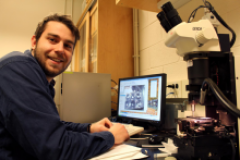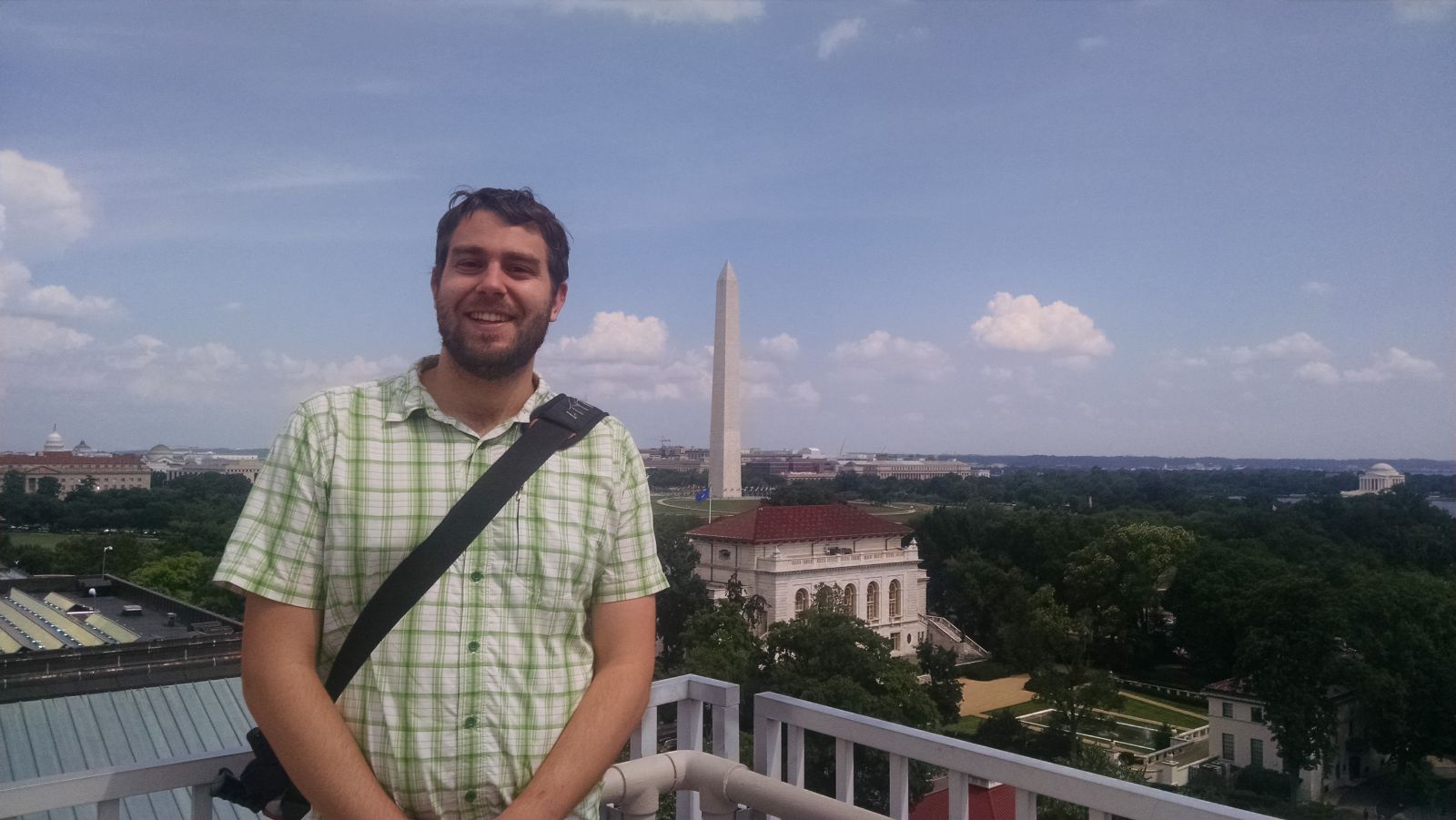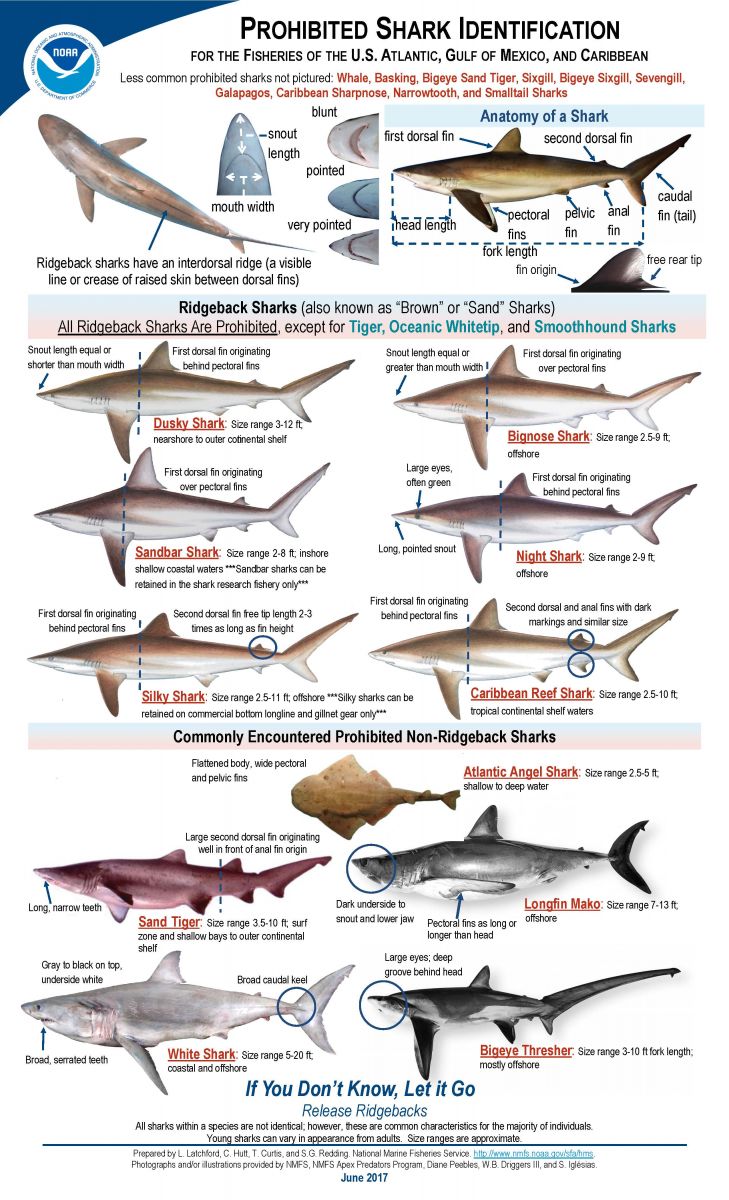Knauss legislative fellowships in Congress help build careers — and they're fun and educational. See our video and fact sheet for details.
From the Water to Washington: Connecting Experiences in DC and Coastal Communities
In graduate school, I found it easy to find the impact and context of my fisheries research. The data I was generating about Atlantic mackerel migration patterns were called for by managers and scientists looking to better understand the decline of the fishery. While, studying at the Chesapeake Biological Laboratory on the lower Patuxent River in Solomons, Maryland, the Chesapeake Bay was right outside my office and home to inspire me to continue doing this rewarding work, and I regularly interacted with the fishermen who relied upon the natural bounty of the Bay’s fish and shellfish for their livelihoods or their entertainment.
|
The author on the Department of the Interior’s rooftop garden in downtown Washington, DC during a fellowship visit. Photo credit: Gray Redding |
My perceptions about the impact of my work changed somewhat earlier this year, when I became a John A. Knauss Marine Policy Fellow with the National Oceanic and Atmospheric Administration’s (NOAA) Fisheries Highly Migratory Species Division. I am helping to write rules and analyze their effects on fishermen and fishing communities; my office’s work has a direct impact on these groups and their ability to continue fishing sustainably in the short and long term. However, the office cubicles at NOAA headquarters in Silver Spring, Maryland, where I work, offer few reminders of the people and places my work affects. Before I moved to the Washington, D.C., area to begin this fellowship, every community I have lived in since college has depended on recreational or commercial fishing. My office has offered me opportunities to continue interacting with these communities, through conversations while attending stakeholder meetings, for example. I also regularly field phone calls on behalf of NOAA Fisheries from constituents seeking to understand our rules and have their voices heard as a part of our decision making. But this is not the same level of connection I felt as a graduate student.
|
The NOAA Ship Oregon II, docked in Pascagoula, MS, before setting off for the 2017 Snapper and Shark Bottom Longline Cruise. Photo credit: Gray Redding |
My Knauss fellowship gave me a wonderful opportunity this July and August to regain that connection: I was invited to participate in a portion of a NOAA Fisheries survey that samples and tags shark species along the Atlantic Coast. I joined this year’s iteration of the Snapper and Shark Bottom Longline survey, spending two weeks aboard the NOAA Ship Oregon II, which is based in Pascagoula, Mississippi, during which I worked alongside volunteers, crew, and NOAA scientists. On this survey we traveled from Mississippi’s Gulf Coast to Cape Lookout, North Carolina, before returning to Cape Canaveral, Florida. Although research is certainly not the same as commercial fishing, the survey offered me a valuable chance to be on the water and gain experiences in the rough sea conditions and long workdays that offshore commercial fishermen face. The trip had personal significance for me, allowing me to see new parts of the ocean and be aboard a ship for two weeks with a great group of people. This trip also helped to highlight the need for part of the work I am doing in Silver Spring, Maryland.
|
Shark identification materials made by NOAA Fisheries. Photo credit: Gray Redding |
During my fellowship, I have been creating educational materials to help fishermen visually identify ridgeback sharks, a diverse group of shark species that have a distinctive ridge behind their dorsal fin along their back. Fishermen are not allowed to keep most of these ridgeback sharks because of low population levels or other issues. Therefore, teaching the fishing community how to identify these sharks is important to avoid accidentally keeping them when caught. I could have helped create these materials without going on the Oregon II, but firsthand experience trying to identify these creatures helped me realize the importance of quick, functional identification guides as tools to teach proper conservation and management. The experienced researchers on my survey could identify the sharks and spout off each one’s scientific species name after one quick glance, but they have seen thousands of sharks through their work. A recreational angler who rarely encounters these species may not know the important anatomical features to look for, and when the shark is thrashing around in the water or on deck, it might not be safe or even possible to spend time looking for these features.
The educational materials created by me and my office have stressed the concept of “If you don’t know, let it go,” suggesting that fishermen release a shark if they cannot positively identify it as a species that they legally may keep. My office is working to create educational materials that are clear and concise enough that in the exciting moments when anglers are struggling to land and bring a shark boatside, they will better understand what species are legal to keep and which should be released with care. The work of NOAA Fisheries and many other federal agencies in Washington, D.C., has large impacts around the country and beyond. Because of this wide impact, it can be difficult to stay connected and aware of all the people and places being affected. I feel one of the best ways to refresh these connections is to get your hands dirty doing research in the field and remind yourself of the natural beauty we work to enhance and maintain.
The work of NOAA Fisheries and many other federal agencies in Washington, D.C., has large impacts around the country and beyond. Because of this wide impact, it can be difficult to stay connected and aware of all the people and places being affected. I feel one of the best ways to refresh these connections is to get your hands dirty doing research in the field and remind yourself of the natural beauty we work to enhance and maintain.
|
The sunset, taken from the Oregon II during the Snapper and Shark Bottom Longline Cruise. Photo credit: Gray Redding |
Photo, upper left: Gray Redding alongside laboratory research equipment used to process fish otoliths, or ear stones, and prepare them from chemical analysis. Photo Credit: Sarah Brzezinski
See all posts to the Fellowship Experiences blog







